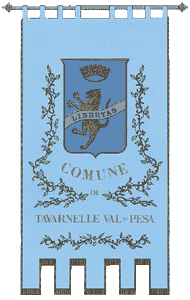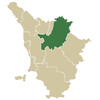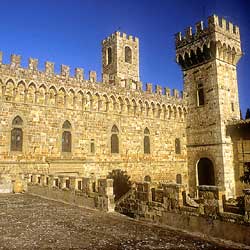|
 Inhabitants in 1991: 6.911
Inhabitants in 1991: 6.911
 The
municipal territory of Tavarnelle extends for 56,98 square kilometres
in a hilly area, on the high plain which divides the Val di Pesa from
the Val d'Elsa. The origins of the municipality are recent being
constituted in 1892 with the districts of Tavarnelle Sambuca and
San Donato in Poggio which had been detached from the municipality of
Barberino Val d'Elsa. From 1909 the new denomination of the municipality
is Tavarnelle Val di Pesa (anter. Tavarnelle). The
municipal territory of Tavarnelle extends for 56,98 square kilometres
in a hilly area, on the high plain which divides the Val di Pesa from
the Val d'Elsa. The origins of the municipality are recent being
constituted in 1892 with the districts of Tavarnelle Sambuca and
San Donato in Poggio which had been detached from the municipality of
Barberino Val d'Elsa. From 1909 the new denomination of the municipality
is Tavarnelle Val di Pesa (anter. Tavarnelle).
The capital took its name from Tabernulae, that is from the ancient
taverns which were posted along the Via Cassia for those who undertook
the journey from Firenze to Siena. On the territory during the Medieval
period certain grand families were Lords, the Albero and the Buodelmonti,
it came under the dominion of Firenze in the first half of the
XIII century, Firenze did not judge it necessary to wall the village being
able to count on the neighbouring castles of San Donato and Barberino
for the defensive system of the area.
 The
development and importance of Tavarnelle however is recent: more important
for its history are surely the districts of San Donato and the Abbey
of Passignano, San Donato in Poggio still today surrounded by walls,
was twice the Seat in 1176 and 1255 of the peace treaty stipulations
between Firenze and Siena and in 1260 the Fiorentino army reunited
at their parish church to prepare for the battle of Montaperti; it was
capital of the community until 1774. The Abbey of Passignano arose
on land which had been an Etruscan and Roman settlement according to
the legend it was founded by San Zanobi in 395; but keeping to history
it is said that it became Vallombrosana from the X century, was one
of the preferred residences of San Giovanni Gualberto, who died there
in 1073. In 1485 the monastery, rich with assets and privileges was occupied
by the military of Lorenzo il Magnifico who had taken command for
his son Giovanni, exiling the monarchs. Giovanni became Pope Leone
X, and gave it back to the Vallombrosani in 1499 and it remained so until
1810 when with the Napoleonic reform the convent was suppressed and
the property sold privately. The
development and importance of Tavarnelle however is recent: more important
for its history are surely the districts of San Donato and the Abbey
of Passignano, San Donato in Poggio still today surrounded by walls,
was twice the Seat in 1176 and 1255 of the peace treaty stipulations
between Firenze and Siena and in 1260 the Fiorentino army reunited
at their parish church to prepare for the battle of Montaperti; it was
capital of the community until 1774. The Abbey of Passignano arose
on land which had been an Etruscan and Roman settlement according to
the legend it was founded by San Zanobi in 395; but keeping to history
it is said that it became Vallombrosana from the X century, was one
of the preferred residences of San Giovanni Gualberto, who died there
in 1073. In 1485 the monastery, rich with assets and privileges was occupied
by the military of Lorenzo il Magnifico who had taken command for
his son Giovanni, exiling the monarchs. Giovanni became Pope Leone
X, and gave it back to the Vallombrosani in 1499 and it remained so until
1810 when with the Napoleonic reform the convent was suppressed and
the property sold privately.
Places to visit:
S. Lucia al Borghetto, ex francescano
convent from 1200. The single nave church is an important example
of Gothic architecture in the territory even though it has suffered
several modifications during the centuries. There are important works
of art in the interior. |
Historical info reproduced upon authorization of
Regione Toscana - Dipartimento della Presidenza E Affari Legislativi e
Giuridici
Picture by Sandro Santioli
Translated by Ann Mountford
|